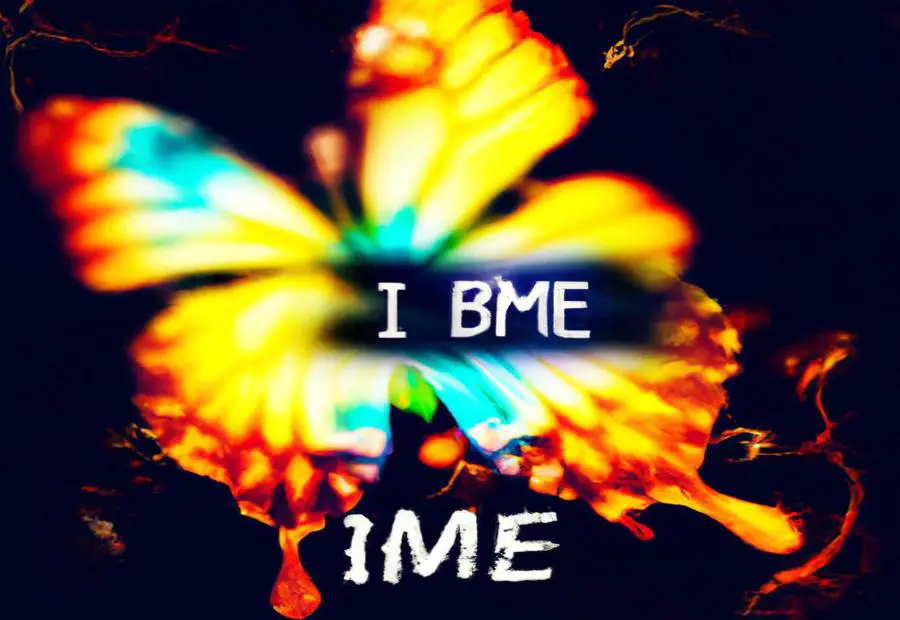Last Updated on July 12, 2023 by Francis
.jpg)
Contents
Key Takeaways:
- The poem “Dream Deferred” by Langston Hughes explores the consequences and effects of delaying or suppressing one’s dreams and aspirations.
- Through the use of vivid imagery and powerful language, Hughes conveys the frustration, anger, and potential for violence that can arise from unfulfilled dreams.
- The poem remains relevant today due to its portrayal of the ongoing struggles faced by marginalized communities, the importance of pursuing and fulfilling one’s dreams, and the potential consequences of societal injustice and inequality.

Photo Credits: Meaning-Of-Number.Com by Michael Baker
The “Introduction” section sets the stage for understanding the message of Langston Hughes’ poem “Dream Deferred.” By exploring the background of Langston Hughes and the cultural movement of the Harlem Renaissance, we gain insight into the context in which the poem was written. Additionally, we will uncover the definition and significance of the poem itself, unraveling its deeper meaning and impact. Get ready to delve into the power and significance of “Dream Deferred” in this section.
Background on Langston Hughes and the Harlem Renaissance
Langston Hughes – a prominent figure of the Harlem Renaissance. He was a prolific writer, poet and playwright, using his work to give voice to the African American experience.
The Harlem Renaissance was a cultural movement in the 1920s and 1930s in New York City. African Americans celebrated their culture and challenged racial stereotypes.
Hughes’ most famous poem – “Dream Deferred” – explores the consequences of delaying or denying one’s dreams and ambitions. Through vivid imagery and language, readers consider the potential outcomes of unfulfilled dreams.
The central theme of “Dream Deferred” is frustration and disappointment from unattained ambitions. Hughes conveys pain and anguish with descriptions such as “Does it dry up like a raisin in the sun?” or “Or fester like a sore– And then run?“
He employs several literary devices – metaphors, similes, rhetorical questions – to enhance the poem’s impact. For example, he compares a deferred dream to a raisin drying up in the sun.
During the Harlem Renaissance, African Americans faced oppression. Segregation laws denied them equal rights and opportunities. This environment created a great artistic outpouring from African American writers, musicians, artists and intellectuals.
The Civil Rights Movement advocated for equal rights. It sought to address systemic racism and fight for desegregation, voting rights and equal opportunities. Hughes and other African American writers used art as expression and resistance against racial inequality.
The themes explored in “Dream Deferred” are still highly relevant. It resonates with individuals facing barriers due to racial discrimination or other forms of oppression. Progress has been made since Hughes’ time, but there is still work to do for true equality.
Definition and significance of the poem “Dream Deferred”
Langston Hughes’ poem “Dream Deferred” has great meaning in the context of the Harlem Renaissance. The poem looks into the result of delaying or denying African Americans’ aims and dreams during a time of racial discrimination and inequality. Its basic yet thought-provoking pictures raise questions about how such deferred dreams affect people and society.
The poem’s importance lies in its capacity to catch the significance of the struggles experienced by African Americans during the Harlem Renaissance. Hughes, a well-known figure in this artistic and cultural movement, used his poetry to exhibit the experiences and emotions of his people. Through “Dream Deferred”, he confronts the results of social unfairness and prejudice on dreams, stressing their potential to cause disappointment, animosity, and despair.
“Dream Deferred” uses several literary devices that add to its deeper importance. The fundamental theme is clear as Hughes uses vivid metaphors and similes to relate a deferred dream to various unfavorable outcomes: “Does it dry up like a raisin in the sun? / Or fester like a sore— / And then run?” These images stir powerful feelings and urge reflection on the results of repressing somebody’s dreams.
To fully comprehend the importance of this poem, it is essential to explore the historical context against which it was written. During the Harlem Renaissance, African Americans faced tremendous challenges in achieving equity and recognition for their creative and intellectual contributions. Systemic racism limited opportunities for success, creating a sense of hopelessness in marginalized communities. This social context gives deeper meaning to Hughes’ exploration of deferred dreams as he reflects on how these restrictions affected people’s aspirations for social mobility and personal fulfillment.
Moreover, “Dream Deferred” can be seen as a significant precursor to later movements, such as the Civil Rights Movement. The struggles highlighted in Hughes’ poem exposed systemic injustice that ultimately led African Americans to demand equal rights and opportunities. By examining this historical context, we can better appreciate the role of African American writers like Hughes in giving voice to the dreams and frustrations of their communities.
The themes and messages expressed in “Dream Deferred” continue to resonate today. The poem’s exploration of the consequences of unfulfilled dreams remains relevant as individuals and societies grapple with issues of social inequality and discrimination. Additionally, while progress has been made since the time of Langston Hughes, achieving true justice is an ongoing battle. “Dream Deferred” serves as a powerful reminder that ignoring or suppressing human aspirations can have far-reaching consequences for both individuals and society as a whole.
Analysis of the poem

Photo Credits: Meaning-Of-Number.Com by Bradley Davis
Laying bare the essence of the iconic poem, we embark on an analysis that dissects its central theme and unravels the intricate web of literary devices employed. Join us as we delve into the heart of “Dream Deferred” to unearth its powerful message and explore the creative tools woven into its poetic tapestry.
Examination of the central theme of the poem
What are the consequences of delaying or suppressing one’s dreams and aspirations? Langston Hughes’ poem “Dream Deferred” examines this question. Through vivid imagery and thought-provoking questions, Hughes delves into the emotional and psychological impacts of unfulfilled aspirations. He paints a picture of bitterness, frustration, and even explosion. It is a critique of societal barriers that stop personal growth and achievement.
Hughes uses several literary devices to deliver his message. He employs similes, like “Does it dry up like a raisin in the sun?” to help readers get a tangible image of the feelings associated with deferred dreams. He also peppers the poem with rhetorical questions, prompting readers to consider their own ambitions and the wider implications of denying individual dreams. The repetition of these questions creates tension and emphasizes the importance of this issue.
In order to understand the central theme of “Dream Deferred”, it is necessary to recognize the context in which it was written: the Harlem Renaissance. This was a period of immense challenge for African Americans, with systemic racism, segregation, and limited opportunities for social mobility. Through artistic and intellectual movements, the Harlem Renaissance sought to celebrate African American culture and fight stereotypes.
The poem is still relevant today. Inequity, injustice, and unequal opportunities still exist, showing that many people have their dreams deferred or denied because of factors such as race, gender, or socioeconomic status. Hughes’ message in ‘Dream Deferred’ reminds us that equality is yet to be achieved.
Discussion of the use of literary devices in the poem
Langston Hughes’ poem “Dream Deferred” uses many literary devices to get its message across. Imagery, simile and repetition are all used to create a vivid and thought-provoking piece.
Imagery is employed to paint a picture in the reader’s head. Asking “Does it dry up/like a raisin in the sun?” The simile not only brings to mind a visual image, but also shows the potential for dreams to shrivel if left unfulfilled.
Repetition is an important device in the poem. “What happens to a dream deferred?” is repeated three times, stressing its central theme. This emphasizes the need to address and resolve deferred dreams, as well as creating a rhythm in the poem.
Similes and metaphors are used to deepen the message. A deferrred dream is compared to a festering sore and rotten meat, illustrating decay and badness. These comparisons add feeling and show the negative consequences of leaving dreams unfulfilled.
In summary, “Dream Deferred” by Langston Hughes uses literary devices to get its powerful message across. Through these tools, he engages the reader and emphasizes the significance of addressing and fulfilling one’s dreams.
Historical context

Photo Credits: Meaning-Of-Number.Com by David Campbell
During the Harlem Renaissance, African Americans faced a myriad of societal issues. This section explores their struggles, as well as the impact of the Civil Rights Movement on African American writers. Unveiling the historical context, we delve into the challenges they encountered, shining a light on the aspirations and obstacles that shaped their artistic expression. From the era’s societal complexities to the revolutionary movements that shaped their narratives, this section offers a deeper understanding of the historical backdrop influencing the message of “Dream Deferred”.
Exploration of the societal issues faced by African Americans during the Harlem Renaissance
During the Harlem Renaissance, African Americans faced hardship. Segregation, discrimination, and limited opportunities were present. They were treated like second-class citizens and faced racism and oppression in education, employment, housing, and social life. This hindered them from taking part and contributing to society.
Langston Hughes’ poem, “Dream Deferred” looks at the issues African Americans faced. It questions what happens when dreams and aspirations are suppressed through adversity. It speaks of unfulfilled potential, frustration, and the effect of deferred dreams on people and communities. Hughes used poetry to bring attention to the struggles during this time in American history.
The Harlem Renaissance gives an understanding of the issues African Americans faced. This cultural movement in 1920s Harlem was a response to unfairness and celebrated black culture and identity with art. But, it was also a time of racial tension and discrimination.
Writers like Langston Hughes were important for giving voice to their experiences and demanding change. Their writings opposed discriminatory practices and asked for equality and justice. This led to the Civil Rights Movement, which brought greater attention to the calls for change.
The themes of “Dream Deferred” are still relevant and remind us of the struggles for justice and equality. Although there have been changes since Langston Hughes’ time, there are still societal issues that need to be addressed for everyone to have equal rights, no matter their race or ethnicity.
Discussion of the Civil Rights Movement and its impact on African American writers
The Civil Rights Movement had a lasting effect on African American writers, such as Langston Hughes. During this time of political and social action, African American authors used literature as a tool to express their feelings and fight for racial equality. This movement gave them a sense of urgency and power, which prompted them to create works that showed the struggles and hopes of their community.
Hughes and other black writers were essential in creating the literature of the Civil Rights Movement. Their writings brought attention to the issues of racism, segregation, and inequality that the oppressed experienced. Through their literary works, they wanted to make a change by challenging the norms.
One of Hughes’ poems, “Dream Deferred”, is proof of his involvement in the Civil Rights Movement. It examines the consequences of not fulfilling one’s goals and dreams, suggesting that it can lead to anger and frustration. By focusing on the dreams of African Americans, Hughes was able to highlight the effects of racism and unfairness.
The impact of the Civil Rights Movement on African American writers is clear. It gave them an opportunity to openly confront racism and use their talent as a form of resistance. With their works, which highlighted the battles African Americans faced, these writers helped to bring about awareness and change.
In today’s world, it is important to understand the continuing relevance of what African American writers wrote during the Civil Rights Movement. Even though there has been progress in civil rights and equality since then, there is still a lot to be done. The legacy of Langston Hughes and others serves to remind us that we must keep striving for true equality for everyone, no matter their race or background. It is important that we keep engaging with their works and find motivation from their voices to keep making progress towards a more inclusive and fair society.
Relevance today

Photo Credits: Meaning-Of-Number.Com by Logan Moore
Examination of how the themes and messages of “Dream Deferred” are still relevant today, along with a discussion of the progress made in achieving equality since the time of Langston Hughes.
Examination of how the themes and messages of “Dream Deferred” are still relevant today
Langston Hughes’ poem “Dream Deferred” still speaks volumes in today’s world. The poem from the Harlem Renaissance delves into the consequences of holding back one’s hopes. The main theme shows the frustration and disaster when someone can’t chase their ambitions.
Hughes uses several literary techniques to get his point across. He uses vivid imagery, so readers can imagine the dangers of deferring dreams, such as a “raisin in the sun” or a “syrup sweet.” Similes and metaphors highlight stronger feelings and experiences.
The Harlem Renaissance was a time of great racial prejudice and limited artistic freedom for African Americans. This background adds more importance to the poem, as it reflects the struggles and desires of the whole community. The Civil Rights Movement also made an impact on African American literature, enabling writers like Hughes to address wrongdoings through their work.
In today’s society, the issues discussed in “Dream Deferred” are still apt. People face barriers that obstruct their dreams, like economic and cultural problems. The poem serves as a reminder to tackle these difficulties and give everyone equal chances to reach their goals.
Though things have improved since Langston Hughes’ time, there’s still much to be done to guarantee everybody has a fair chance to pursue their dreams. By examining and understanding the ideas in “Dream Deferred,” we can strive towards a society where everyone has the opportunity to fulfill their aspirations.
Discussion of the progress made in achieving equality since the time of Langston Hughes
Progress has been made in achieving equality since the time of Langston Hughes. During the Harlem Renaissance, African Americans faced discrimination, segregation, and limited opportunities. However, the Civil Rights Movement brought change to fight for equality. Activists advocated for equal rights and an end to racial injustice. Writers like Hughes expressed their experiences through literature and poetry. His poem “Dream Deferred” highlighted the realities faced by African Americans and called attention to these issues.
In recent years, there is increased awareness of systemic racism and social injustices. The message of “Dream Deferred” is relevant today. It explores the consequences of suppressing dreams and desires. The poem reminds us that when people’s aspirations are delayed or denied, it can lead to destruction. By acknowledging and addressing these concerns, society has taken steps towards equity.
Despite progress, challenges remain in achieving complete equality. Systemic racism still impacts education, employment opportunities, and criminal justice. Legislation and policies promote equality and combat discrimination, but more work is needed to eradicate racial disparities.
The lasting impact and significance of Langston Hughes and his poem ‘Dream Deferred’ show that a deferred dream can ignite a powerful revolution for equality.
Conclusion

Photo Credits: Meaning-Of-Number.Com by Elijah Jackson
In the conclusion, we will recap the main points discussed in the analysis and delve into the lasting impact and significance of Langston Hughes and his poem “Dream Deferred.”
Recap of the main points discussed in the analysis
In analyzing Langston Hughes’ poem “Dream Deferred,” several points were addressed. The main theme was the consequences of ignoring one’s dreams. Similes, metaphors, and imagery were examined to highlight the emotional impact.
The Harlem Renaissance was discussed. This era saw African Americans achieving culturally and artistically, but also facing systemic racism and injustice.
The Civil Rights Movement was also considered. It provided a platform for advocating equality and challenging discrimination.
The themes and messages of “Dream Deferred” still hold relevance today. Its exploration of dreams unfulfilled resonates with people facing barriers in pursuing their aspirations.
It is clear “Dream Deferred” continues to have an enduring effect on literature and society. It speaks to universal experiences and serves as a reminder of ongoing efforts for equality and social progress.
Final thoughts on the lasting impact and significance of Langston Hughes and his poem “Dream Deferred”
Langston Hughes and his poem “Dream Deferred” have had an influence that will last through the ages. His words captured the spirit of the Harlem Renaissance and drew attention to the African American’s struggles of that time. “Dream Deferred” has an important meaning, with its exploration of the outcomes of putting dreams off.
The primary focus of “Dream Deferred” is the disappointment and possible consequences of unfulfilled dreams. Hughes put strong imagery in his writing, to show the emotional heaviness and social effects of delaying dreams. His use of questions and metaphors invite readers to think about the effects of prejudice and oppression.
The Harlem Renaissance was a time of great hardship for African Americans. Racial segregation, limited educational and occupational chances, and widespread bias were just some of the issues they were facing. This helps people to understand why Hughes wrote about deferred dreams. His poem was a voice for those who were ignored, a way for them to express their aggravation and desire for a better future.
The Civil Rights Movement changed the lives of African American writers, including Langston Hughes. It created a spark for social change, inspiring authors to write about the wrongs in society. “Dream Deferred” became more powerful, becoming an anthem for those seeking equal rights and chances.
To this day, the ideas explored in “Dream Deferred” are still relevant. Racial injustice still exists. Even though progress has been made since Hughes’ time, there is still much work to be done, to make sure that all people have equal rights and opportunities. This poem is a reminder that waiting on dreams can have long-term effects on both individuals and communities. It emphasizes how critical it is to fix social problems.
To finish, Langston Hughes and his poem “Dream Deferred” made a lasting impression on literature and society. They showed the African American’s struggles and wishes during the Harlem Renaissance. The poem’s examination of the results of pushing dreams aside is still meaningful today, serving as a reminder of the importance of tackling social issues and achieving true equality for all.
Some Facts About the Message of “Dream Deferred” by Langston Hughes:
- ✅ The message of “Dream Deferred” is about the frustration and despair of African-Americans who have been discriminated against based on their color. (Source: englishsummary.com)
- ✅ Langston Hughes uses similes to compare a deferred dream to various things that rot or deteriorate due to delay. (Source: englishsummary.com, poemanalysis.com)
- ✅ The poem explores the themes of dreams, equality, delay, sadness, and hopelessness. (Source: wordsrum.com)
- ✅ Langston Hughes expresses a sense of hopelessness about whether the dream of equality and freedom for African-Americans will ever be realized. (Source: wordsrum.com)
- ✅ The use of vivid similes emphasizes the negative consequences of delaying a dream. (Source: englishsummary.com)
FAQs about What Is The Message Of Dream Deferred
What is the message of “Harlem (Dream Deferred)” by Langston Hughes?
The message of “Harlem (Dream Deferred)” is that the delay or postponement of a dream can have negative consequences. The poem uses vivid imagery and similes to compare a deferred dream to rotting food items and a festering sore. It suggests that a deferred dream can become like a heavy load or explode with anger, highlighting the frustration and despair of African-Americans who have been discriminated against based on the color of their skin.
What is the significance of the biblical reference in “Harlem (Dream Deferred)”?
The biblical reference in “Harlem (Dream Deferred)” adds a sense of seriousness and timeless importance to the idea of a deferred dream. The opening question of the poem, “What happens to a dream deferred?”, draws on biblical language and evokes a sense of anticipation for a divine answer. By using this reference, Langston Hughes emphasizes the gravity of the theme and suggests that the consequences of delaying dreams can be deeply meaningful and impactful.
How does Langston Hughes depict the frustration of African-American artists in “Harlem (Dream Deferred)”?
In “Harlem (Dream Deferred)”, Langston Hughes depicts the frustration of African-American artists by comparing their disappointment to a festering sore. He highlights the ongoing inequality faced by African Americans, who were only acknowledged within their own community during the Harlem Renaissance. By describing their dreams as being segregated from those of white writers, Hughes conveys his desire for his work to be recognized by the world and challenges discrimination through his writing.
What literary devices does Langston Hughes use in “Harlem (Dream Deferred)”?
Langston Hughes uses several literary devices in “Harlem (Dream Deferred)” to convey his message. He employs similes to compare a deferred dream to various food items, such as a dried up raisin in the sun, a festering sore, and stinking rotten meat. These similes evoke vivid and sensory images to emphasize the negative consequences of delaying dreams. Hughes also uses enjambment, where a thought or phrase carries over from one line to another without a pause, to create a sense of flow and tension in the poem. Additionally, he uses personification to give human qualities to the dream itself, describing it as a heavy load that weighs on a person’s back.
What does Langston Hughes imply with the last line of “Harlem (Dream Deferred)”?
The last line of “Harlem (Dream Deferred)”, which is italicized, implies that something significant is about to happen. It suggests that the African-American community, represented by the deferred dreams, cannot tolerate mistreatment and inequality much longer. Langston Hughes expresses a sense of urgency and a desire for change, indicating that the dream of equality and freedom for African-Americans cannot be postponed indefinitely.
How did Langston Hughes challenge discrimination through his writing in “Harlem (Dream Deferred)”?
Langston Hughes challenged discrimination through his writing in “Harlem (Dream Deferred)” by using powerful imagery and evocative language to highlight the struggles faced by African-Americans. Rather than exploding in anger, Hughes used his poetry to shine a light on the inequality and segregation experienced by the African-American community. By expressing his frustration and sadness over the lack of recognition for his work and the importance given to his race, Hughes sought to pave the way for civil rights and equal treatment for African-Americans.






